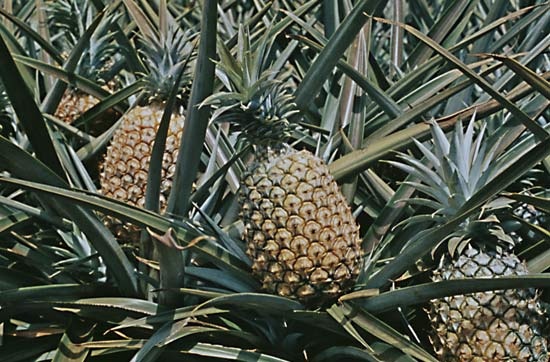pineapple
plant
 (Ananas comosus), fruit-bearing plant of the family Bromeliaceae, native to tropical and subtropical America but introduced elsewhere. The pineapple plant resembles the agave or some yuccas in general appearance. It has from 30 to 40 stiff, succulent leaves closely spaced in a rosette on a thick, fleshy stem. With commercial varieties, a determinate inflorescence forms about 15 to 20 months after planting on a flower stalk 100–150 mm (4–6 inches) in length. The originally separate light purple flowers, together with their bracts, each attached to a central axis core, become fleshy and fuse to form the pineapple fruit, which ripens five to six months after flowering begins. Fruits of commercial varieties range from 1 to 2 kg (2 to 4 pounds) in weight. The earliest written references to pineapple are by Columbus, Gonzalo Fernández de Oviedo y Valdés, and Sir Walter Raleigh, who found pineapple growing in the West Indies, where it was used for food and wine making.
(Ananas comosus), fruit-bearing plant of the family Bromeliaceae, native to tropical and subtropical America but introduced elsewhere. The pineapple plant resembles the agave or some yuccas in general appearance. It has from 30 to 40 stiff, succulent leaves closely spaced in a rosette on a thick, fleshy stem. With commercial varieties, a determinate inflorescence forms about 15 to 20 months after planting on a flower stalk 100–150 mm (4–6 inches) in length. The originally separate light purple flowers, together with their bracts, each attached to a central axis core, become fleshy and fuse to form the pineapple fruit, which ripens five to six months after flowering begins. Fruits of commercial varieties range from 1 to 2 kg (2 to 4 pounds) in weight. The earliest written references to pineapple are by Columbus, Gonzalo Fernández de Oviedo y Valdés, and Sir Walter Raleigh, who found pineapple growing in the West Indies, where it was used for food and wine making.The Portuguese were apparently responsible for early dissemination of the pineapple. They introduced it to Saint Helena shortly after they discovered that island in 1502. Soon after, they carried it to Africa and, by about 1550, to India. Before the end of the 16th century, cultivation of the plant had spread over most of the tropical areas of the world, including some of the islands of the South Pacific.
When pineapple is cultivated on modern plantations, an asphalt-impregnated mulch paper is usually first laid on well-tilled soil in rows, with the edges covered to anchor the strips of paper. The pineapple propagating pieces are inserted through the paper into the soil, so spaced as to give a population of 15,000–20,000 plants per acre. The pineapple has become a characteristic ingredient in the meat, vegetable, fish, and rice dishes of what is loosely termed Polynesian cuisine, a blend of various Oriental styles of cooking. The fruit is eaten fresh where available and in canned form worldwide. In the United States and in Europe it is sometimes used as a pastry filling or in baked desserts.
Total world production of pineapples ordinarily averages about 8,300,000 metric tons annually, of which an estimated 20 percent is produced in Thailand, which during the 1970s replaced the former leading producer, the Hawaiian Islands. Other areas of substantial production include the Philippines, China, Brazil, Mexico, Côte d'Ivoire, India, and Taiwan.
- Albertina Graphics Collection
- Albertina Rasch
- Albertine-Adrienne Necker de Saussure
- Albertinelli, Mariotto
- Albertini, Luigi
- Albertino Mussato
- Albertinum
- Alberti, Rafael
- Albert J. Beveridge
- Albert John Luthuli
- Albert Kahn
- Albert Kesselring
- Albert King
- Albert, Lake
- Albert Lasker
- Albert Lea
- Albert Lebrun
- Albert L. Murray
- Albert Lortzing
- Albert l'Ouvrier
- Albert Ludwig University of Freiburg
- Albert Mangelsdorff
- Albert Mansbridge
- Albert Memmi
- Albert Memorial